Table of Contents
- Introduction
- Editor’s Choice
- Global Digital Signage Market Statistics
- Global Digital Signage Market Share – By Regional Statistics
- Digital Signage Key Players and Market Share Statistics
- Applications of Digital Signage Statistics
- Digital Signage Sector Statistics
- Advantages, Solutions in Corporates and Employees
- Digital Signage in Worship Venues Statistics
- DOOH & Digital Signage Statistics
- Recent Development
- Conclusion
- FAQs
Introduction
Digital Signage Statistics: Digital signage involves the utilization of electronic displays such as LCD or LED screens to transmit multimedia content. Serving as a modern replacement for conventional static signs.
Over time, it has undergone significant advancements and is now prevalent in a wide array of public venues. Typically, digital signage encompasses display screens, media players, content management systems, and the network infrastructure for connectivity.
The content displayed can encompass text, images, videos, and animations administered through specialized software.
This technology serves many purposes in retail, hospitality, transportation, healthcare, and corporate environments. Providing advantages such as heightened engagement, improved customer experiences, and cost-effectiveness.
Nonetheless, it does come with its share of challenges, including technical glitches, intricate content management, and security considerations.
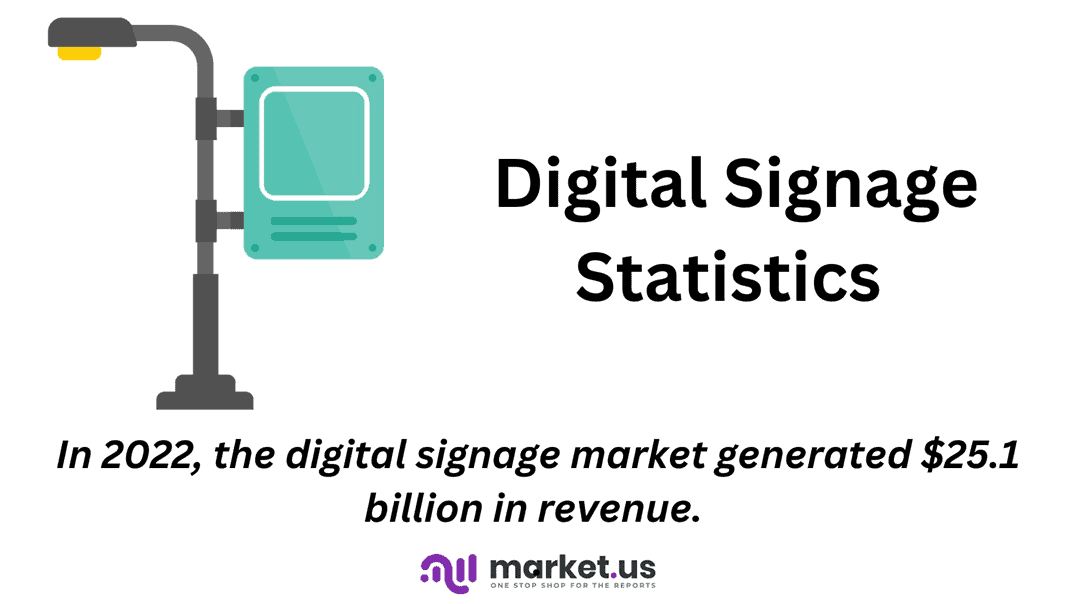
Editor’s Choice
- The digital signage market has been experiencing robust growth in recent years. With revenues steadily climbing at a CAGR of 7.7%.
- In 2022, the digital signage market generated $25.1 billion in revenue, projected to rise to $52.7 billion in 2032.
- In 2022, it was revealed that nearly half of the individuals who sign up for new gym memberships end up canceling them within the first six months.
- Meanwhile, the adoption of digital signage solutions is steadily gaining momentum. Roughly 60% of businesses that currently do not employ digital signage in their establishments planning to invest in this technology over the next two years.
- Moreover, a significant majority of current users of digital signage surpasses 67%. They have expressed their intention to increase their spending on out-of-home advertising through digital signage in the coming two years.
- For 46.1% of churches, social media has emerged as the primary outreach method. The seamless integration of these platforms into digital signage presents an effective means to enhance engagement.
- Recent data also indicates that a substantial portion of users, approximately 33%. Manage anywhere from 1 to 24 digital display or signage screens, while 15% oversee operations involving 15 to 99 screens.
- Among the brands offering digital communication systems. A noteworthy 80% have reported experiencing a boost in sales, often reaching up to 33%.
Global Digital Signage Market Statistics
Digital Signage Market Size Statistics
- The digital signage market has been experiencing robust growth in recent years. With revenues steadily climbing at a CAGR of 7.7%.
- In 2022, the market generated $25.1 billion in revenue, projected to rise to $27.1 billion in 2023.
- The upward trend is expected to continue, with estimated revenues of $28.9 billion in 2024, $31.8 billion in 2025, and $34.7 billion in 2026.
- By 2027, the market is predicted to reach $37.1 billion, and this growth trajectory shows no signs of slowing down. With revenues forecasted to reach $38.9 billion in 2028 and $41.9 billion in 2029.
- As we move into the next decade, the digital signage market is set to surpass the $44.8 billion mark in 2030, $48.4 billion in 2031, and an impressive $52.7 billion in 2032.
- This consistent and significant expansion underscores the increasing importance of digital signage. In various industries and its role in shaping the future of advertising and communication.
(Source: Market.us)
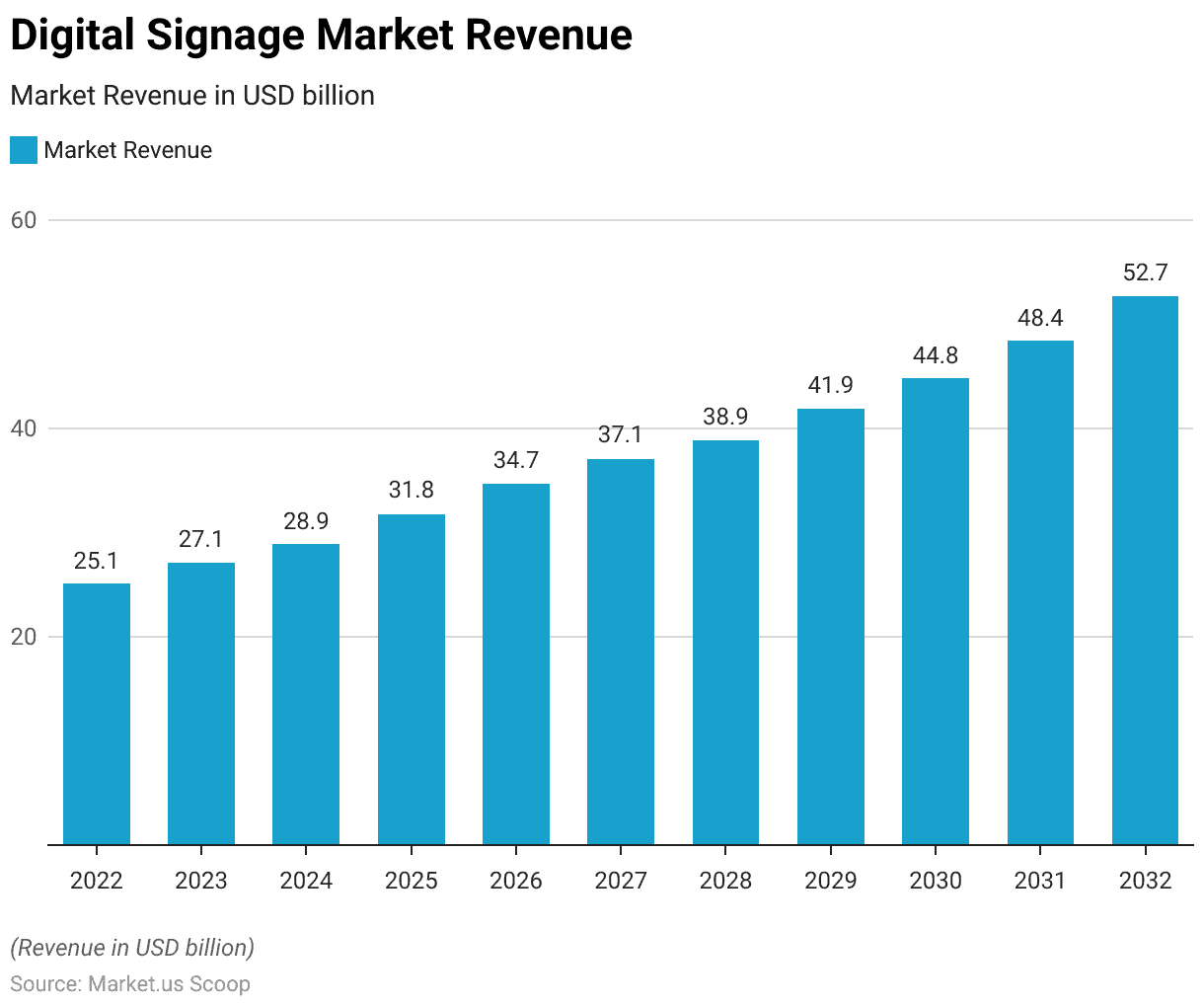
Digital Signage Market Revenue – By Type Statistics
- The global digital signage market is showing strong growth prospects over the coming years. With a steady increase in total market revenue.
- In 2022, the market generated a total revenue of USD 25.1 billion.
- This revenue was distributed across various digital signage solutions. Including video walls, video screens, digital posters, transparent LED screens, kiosks, and other digital displays.
- Video walls accounted for USD 7 billion in revenue, while video screens contributed USD 6 billion.
- Digital posters and transparent LED screens generated USD 4 billion. Kiosks and other digital signage solutions brought in USD 2 billion and USD 4 billion, respectively.
- As we look ahead, the market is projected to continue its upward trajectory. Reaching USD 27.1 billion in total revenue in 2023.
- This growth trend is expected to persist, with total market revenue increasing to USD 28.9 billion in 2024, USD 31.8 billion in 2025, and USD 34.7 billion in 2026.
- Video walls, screens, and digital posters are expected to maintain prominence. With steady revenue growth in the coming years.
- By 2032, the global digital signage market is anticipated to reach a substantial total revenue of USD 52.7 billion. Various digital displays contribute to this significant market size.
- This data underscores the increasing adoption of digital signage solutions across various industries and the evolving consumer preferences for engaging visual communication.
(Source: Market.us)
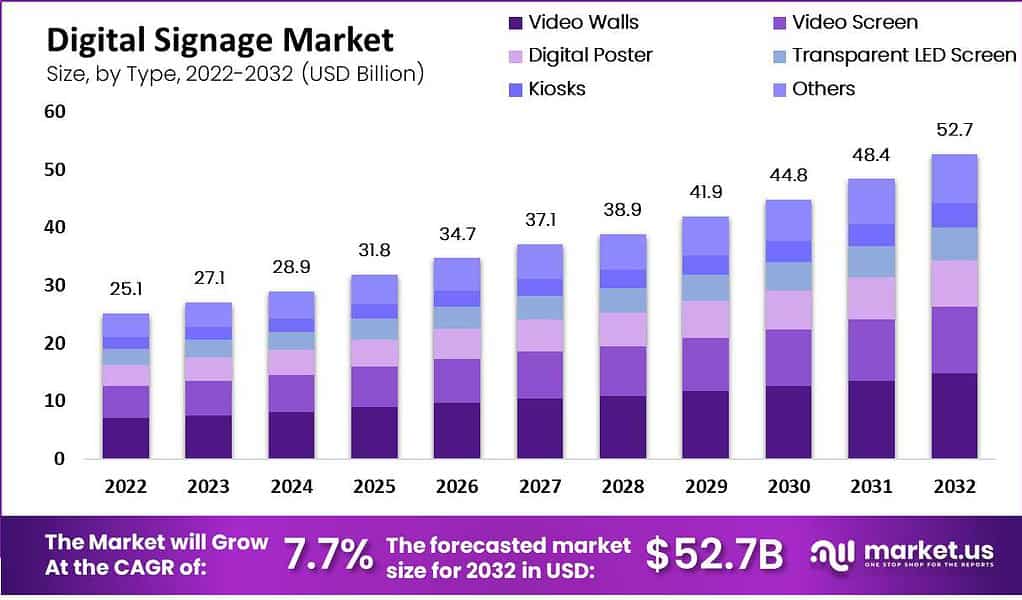
- The global digital signage market is distributed across different regions, each contributing to its growth and development.
- North America is a major player, commanding a substantial market share of 33.8%.
- Europe follows closely behind, with a significant share of 25.4%. Indicating a strong presence of digital signage solutions in the region.
- The Asia-Pacific (APAC) region is also a noteworthy contributor, accounting for 30.1% of the market share. Highlighting the growing adoption of digital signage in emerging markets.
- In contrast, Latin America and the Middle East & Africa (MEA) regions hold relatively smaller market shares of 6.9% and 3.8%, respectively.
- While they may have a smaller footprint in the global digital signage landscape. These regions still represent market expansion and growth opportunities.
- Overall, this regional breakdown illustrates the global distribution of the digital signage market. With North America, Europe, and APAC leading the way in terms of market share.
- At the same time, Latin America and MEA contribute to the market’s diversity and potential for future development.
(Source: Market.us)
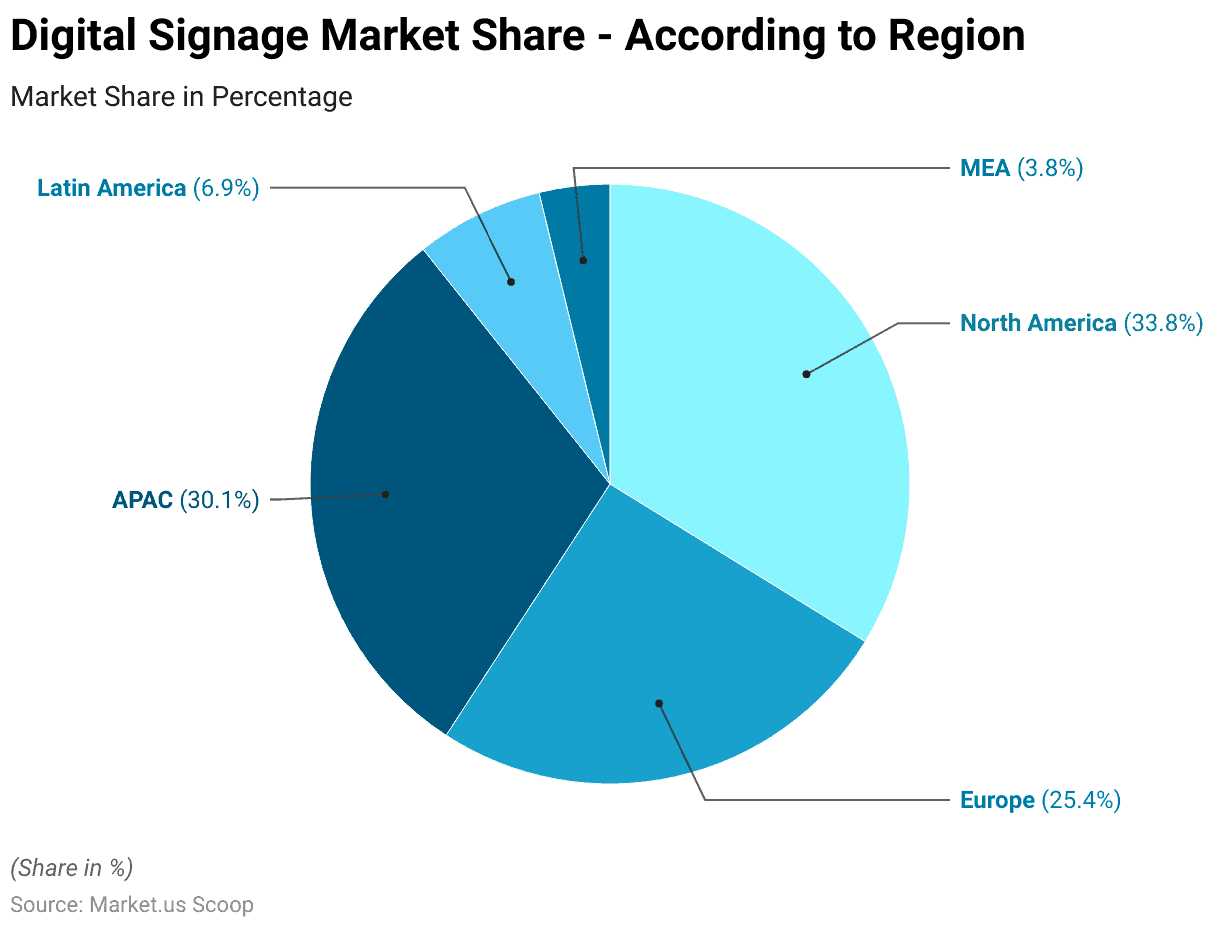
- In the competitive landscape of the digital signage industry, several key players hold significant market shares.
- Samsung Electronics and Panasonic Corporation each have a noteworthy 12% share of the market, showcasing their strong presence and influence.
- Exceptional 3D follows closely behind with a 15% market share, demonstrating its prominence in the industry.
- LG Electronics and Sony Corporation hold 11% and 9% of the market share, respectively. Contributing to the diversity of digital signage providers.
- Leyard Optoelectronic Co., Ltd. and Scala also play essential roles in this dynamic market. With 8% and 9% market shares, respectively.
- These companies bring their unique offerings and capabilities to the digital signage space.
- Additionally, other key players collectively account for 14% of the market share. Underlining the presence of various competitors vying for their share of the digital signage market.
- Overall, this data reflects a competitive landscape where several major players and other companies actively shape the digital signage industry. Each brings its strengths and innovations to meet the market’s and its customers’ evolving needs.
(Source: Market.us)
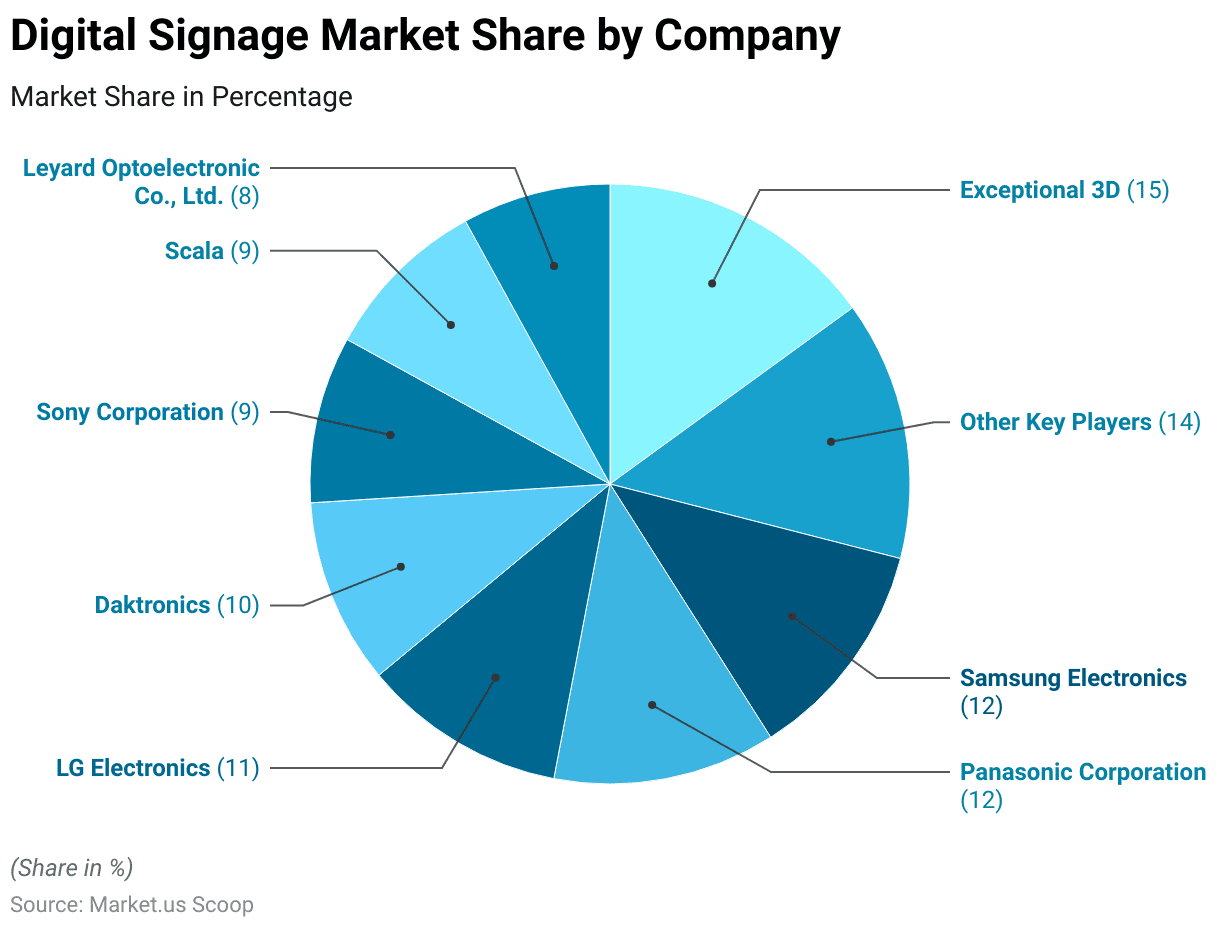
Applications of Digital Signage Statistics
Education Sector
- A significant 73% of educational institutions recognize the vital role of digital signage in shaping future communication.
- On college campuses, 70% have implemented digital displays, and 87% of educational establishments from K-12 education to higher education have adopted digital signage systems to enhance communication and optimize their teaching strategies.
- Colleges and universities leverage digital signage solutions to enhance communication and provide valuable information to their campus communities.
- One hundred percent of these educational institutions use digital signage for institutional news and announcements. Ensuring that students and staff are updated with important updates and events.
- Additionally, 86% of colleges and universities utilize digital menu boards in dining facilities. Offering a dynamic and engaging way to showcase menu items and promotions.
- In the academic realm, classroom scheduling and emergency notifications are efficiently managed through digital signage by 57% of these institutions. Improving the dissemination of crucial information during emergencies.
- Furthermore, 43% of colleges and universities employ digital signage for wayfinding, assisting students and visitors in navigating the campus effectively, and for room signs, which aid in location identification.
- Lastly, some institutions explore revenue generation by incorporating third-party advertising on their digital signage screens. With 14% of colleges and universities using this approach.
- The widespread adoption of digital signage solutions in higher education institutions underscores their versatility in serving various purposes. From information dissemination to enhancing the campus experience.
(Source: Digital Signage Today)
Digital Signage Sector Statistics

Manufacturing
- The United States incurs a substantial annual cost of $170 billion due to workplace injuries, illnesses, and fatalities.
- This significant financial burden could otherwise be reinvested into businesses for growth and development.
- However, implementing safety and health communication strategies, such as digital signage, has shown remarkable results.
- These measures have led to reductions of 20% or more in the rates of workplace injuries and illnesses. In manufacturing, 93% of companies employ digital signage to showcase their products at trade shows and exhibitions.
- Moreover, 9 out of 10 manufacturers leverage digital signage solutions to enhance employee training programs, ultimately boosting productivity.
- Notably, the adoption of digital signage has been linked to a 22% improvement in workplace engagement, resulting in a 41% decrease in the occurrence of quality defects.
- Importantly, every dollar invested in meaningful safety solutions yields impressive benefits, with companies realizing returns ranging from $4 to $6.
(Source: ICX Association)
Banking & Finance
- Studies suggest that having digital signage in a bank branch enhances the perception of trustworthiness among customers, with 87% sharing this view.
- Surveys also indicate that a significant majority, 87%, of consumers, primarily consisting of millennials at 97%, actively utilize mobile banking applications.
- Consequently, it is advisable that when integrating digital signage, banks creatively highlight their mobile apps and their features, as this can serve as a persuasive tool for those who have not yet adopted digital banking with the bank.
- Moreover, during their wait in branch queues, many customers tend to feel impatient and perceive their waiting time as longer than it is.
- To address this issue, 60% of banks have turned to digital signage, which provides engaging content, with 75% related to bank updates and 25% offering other news to keep customers engaged.
- The global digital payment economy is poised to reach a substantial value of USD 12.55 trillion by 2027, with an estimated compound annual growth rate (CAGR) of 10.9% from 2021 to 2027.
- Significantly, 9 out of 10 banks acknowledge the importance of digital signage in shaping their in-branch marketing strategies.
(Source: Pickcel)
Retail
- A considerable 90% of shoppers find videos displayed on screens to be valuable when making purchasing decisions.
- Therefore, if your store already employs digital screens, it’s advisable not to leave the content static; instead, consider showcasing engaging video content to enhance your brand’s effectiveness in selling.
- Impressively, 76% of American consumers are inclined to enter a store for the first time when drawn by appealing digital signage.
- Additionally, 67% of consumers report frequently purchasing products based on the visual content they see on digital signs.
- The introduction of digital signage has led to a notable 24% increase in foot traffic for retail stores. Among brands already utilizing digital signage, a substantial 80% have observed sales growth of up to 33%.
- Notably, nearly 80% of millennials prefer shopping at stores equipped with mobile customer service portals or interactive kiosks.
- Furthermore, digital signage effectively reduces the perceived waiting time by 35%, significantly contributing to streamlined queue management.
(Source: Magestore)
Media & Advertising
- An overwhelming 91% of advertisers recognize that consumers now anticipate personalized and engaging advertisements, a capability readily offered by digital signage.
- Remarkably, 52% of global marketers prioritize digital solutions as their primary strategic focus for profitability.
- The adoption of omnichannel experiences by companies has seen a substantial rise, surging from 20% to over 80% in recent years. Digital signage plays a pivotal role in achieving success in this context.
- Notably, 76% of companies are investing in emerging technologies such as interactive kiosks, touchscreen wayfinding guides, and IoT-based digital signage.
- Moreover, 86% of companies consider cloud technology a critical component of their digital transformation efforts, extending to cloud-based digital signage solutions.
- A 2010 Arbitron study shows that digital signs have a remarkable reach among Americans. With 70% reporting they have viewed a digital video display in the past month.
- This surpasses the number of people who have seen content on the Internet. Which stands at 43%, or on Facebook at 41%.
- Digital signage leaves a lasting impression, as out of the 70% of Americans who recall encountering a digital video display recently. 47% specifically remember seeing an advertisement, almost half of them.
- Additionally, among travelers who remember noticing a digital billboard, an impressive 82% recall that it was displaying an ad.
- A 2012 Swedish study discovered that drivers spend considerably more time gazing at digital billboards than traditional ones.
- More recently, it was found that 55% of individuals who observed a digital billboard could remember the specific message it displayed each time they passed by one.
(Source: Sixteen: Nine, Pickcel)
Healthcare
- Efficient utilization of Internet of Things (IoT) healthcare technologies has the potential to generate savings of more than $300 billion within the healthcare industry.
- A significant 70% of hospitals have embraced digital communication systems.
- Furthermore, 64% of physicians believe that IoT can help alleviate the workload of nurses and doctors.
- It’s worth mentioning that 75% of caregivers and patients who engage with hospital messaging via digital signage find the content enhances the hospital experience and delivers valuable health information.
- Concerning patient involvement, 78% actively seek digital health solutions whenever possible, and 52% obtain health-related information from digital signage.
- 75% of individuals exposed to digital signage within a hospital can recall at least one message.
- Additionally, 83% of patients spend substantial time engaging with a hospital’s digital content.
- Moreover, 27% of patients have discovered healthcare providers through digital messaging.
- Medical facilities that incorporate displays often experience business growth ranging from 15% to 150%.
- It’s crucial to highlight that hospitals face significant inefficiencies, resulting in an annual waste of $12 billion due to ineffective communication practices.
(Source: Digital Signage Today)

Advantages, Solutions in Corporates and Employees
- Human resources (HR) managers and business leaders recognize the significance of digital signage in fostering employee engagement.
- Nearly 56% of teams responsible for internal communication contemplate investments in digital signage.
- Among communication professionals, 50% utilize digital signage as a communication platform.
- Digital signage has enhanced internal communication, leading to a notable 25% increase in productivity.
- Furthermore, companies with effective internal communication witness employees who are four times more likely to feel engaged, while disengaged employees are twelve times more likely to resign within a year.
- It’s worth noting that approximately 46% of employees feel unfamiliar with their company’s core values.
- Presentations incorporating visual elements have demonstrated a 43% higher persuasiveness and influence than those lacking visual aids.
- Additionally, over a quarter of US companies prioritize multichannel campaign strategies incorporating digital signage content.
(Source: Easy Signage)
Digital Signage in Worship Venues Statistics
- Churches typically allocate around $6,500 annually for photocopying, paper, and printing expenses.
- However, adopting digital signage has led to a substantial 76% reduction in these costs.
- Notably, there has been a significant 72% increase in technology integration in churches led by Baby Boomers.
- Around 52.9% of religious organizations employ projectors and various digital signage to deliver sermons.
- Moreover, 4 out of every five places of worship maintain websites and actively incorporate modern technologies to engage with a wider audience, particularly the younger generation.
- These web pages can also be seamlessly displayed on digital signage.
- Additionally, 7 out of 10 practicing Christian Millennials prefer reading scriptures from a screen, presenting an opportunity to enhance engagement during sermons by displaying scripture on digital signage.
- Furthermore, 46.1% of churches have identified social media as their most effective outreach method. With the potential to extend the reach of messages by displaying social media feeds on digital signage.
(Source: MVIX)
DOOH & Digital Signage Statistics
- As of September 2022, 98% of consumers have frequented at least one Digital Out-of-Home (DOOH) venue within the past month.
- Many individuals encounter multiple DOOH screens daily. This medium has seamlessly integrated into our daily lives, making it nearly impossible not to come across it, yet it does so without being overly intrusive.
- This integration gives advertisers an impactful means of reaching consumers without causing disruption.
- Impressively, 84% of consumers can recall encountering DOOH ads.
- Compared to a recent study by Kantar and Snapchat that examined social media advertising recall, Gen-Z reported a 55% recall rate. While older generations like millennials (46%) and boomers (26%) had even lower recall rates for social media advertising.
- Therefore, if your goal is to make a compelling impact while avoiding some of the challenges associated with other digital channels, such as fraud, brand safety, and privacy concerns, DOOH may be the solution.
(Source: Vistar Media)
Recent Development
Acquisitions and Mergers:
- Sony acquires Nevion: In late 2023, Sony completed its acquisition of Nevion. A provider of virtualized media production solutions, for $150 million. This acquisition aims to enhance Sony’s digital signage offerings by integrating Nevion’s expertise in IP-based broadcast solutions.
- LG acquires Navori Labs: LG acquired Navori Labs, a leading digital signage software company, for $200 million in early 2024. This merger is expected to strengthen LG’s position in the digital signage market by combining its hardware with Navori’s advanced software solutions.
New Product Launches:
- Samsung’s Neo QLED Signage: In mid-2023, Samsung introduced its Neo QLED digital signage displays, featuring enhanced brightness, higher resolution, and improved energy efficiency. These displays are designed for various commercial applications, including retail and corporate environments.
- Sharp’s 8K Digital Signage: Sharp launched an 8K digital signage display in early 2024, offering ultra-high-definition visuals for applications requiring exceptional image quality, such as luxury retail and high-end corporate presentations.
Funding:
- BrightSign secures $100 million: BrightSign, a leading provider of digital signage media players, raised $100 million in funding in 2023 to expand its product line and enhance its software platform for better performance and usability.
- SignageLive raises $50 million: In early 2024, SignageLive, a cloud-based digital signage platform, secured $50 million to develop new features, improve integration capabilities, and expand its global market presence.
Technological Advancements:
- AI and Machine Learning Integration: AI and machine learning are being integrated into digital signage systems to provide personalized content, real-time analytics, and interactive capabilities. These advancements improve audience engagement and marketing effectiveness.
- Edge Computing for Digital Signage: Edge computing technology is enhancing digital signage by enabling faster data processing, reducing latency, and improving the reliability of real-time content updates.
Market Dynamics:
- Growth in Digital Signage Market: The global digital signage market is projected to grow at a CAGR of 7.5% from 2023 to 2028, driven by increasing demand for dynamic and interactive displays in retail, transportation, and corporate sectors.
- Increased Adoption in Healthcare: Digital signage is seeing increased adoption in healthcare facilities for patient communication, wayfinding, and information dissemination, enhancing the patient experience and operational efficiency.
Regulatory and Strategic Developments:
- Energy Efficiency Standards: Governments are implementing stricter energy efficiency standards for digital signage displays to reduce power consumption and environmental impact, encouraging the development of more sustainable solutions.
- Data Privacy Regulations: As digital signage systems become more interactive and data-driven, compliance with data privacy regulations like GDPR and CCPA is crucial to protect user information and ensure ethical data usage.
Research and Development:
- Advanced Display Technologies: R&D efforts are focusing on developing advanced display technologies, such as microLED and OLED, to offer higher brightness, better color accuracy, and longer lifespan for digital signage applications.
- Interactive and Touchless Solutions: Researchers are exploring interactive and touchless solutions for digital signage, such as gesture recognition and voice control, to enhance user interaction while maintaining hygiene and safety in public spaces.
Conclusion
Digital Signage Statistics – In conclusion, digital signage has become a pivotal communication tool in various sectors, offering benefits such as heightened engagement, cost savings, and improved customer experiences.
Its widespread adoption is evident, with businesses and organizations recognizing its growth potential. The statistics underscore its influence on customer behavior, employee engagement, and overall business success.
Digital signage’s versatility, from reducing printing expenses to expanding audience reach, positions it as a critical asset in today’s competitive landscape.
As technology advances, digital signage is poised to integrate seamlessly with emerging trends, ensuring its continued relevance for conveying information, promoting products, and engaging audiences in the years ahead.
FAQs
Digital signage is a technology that uses electronic displays, such as LCD or LED screens, to show multimedia content, replacing traditional static signs. It can display various content, including text, images, videos, and animations, and is typically managed through specialized software.
Digital signage is used in various settings, including retail stores, restaurants, airports, hotels, healthcare facilities, corporate offices, transportation hubs, and public spaces. It serves various purposes, from advertising and branding to providing information and enhancing customer experiences.
Digital signage systems typically include display screens, media players, content management software, and connectivity infrastructure. The software creates and schedules content and then displays it on the screens. Content can be updated remotely, making managing and customizing messages in real-time easy.
Digital signage offers several advantages, including increased engagement with audiences, improved customer experiences, cost savings on printing and distribution, dynamic and real-time content updates, and the ability to target specific demographics with relevant messages.
Challenges associated with digital signage can include technical issues, content management complexity, security concerns, and the initial investment cost. Having a clear strategy and plan to address these challenges is important.
Discuss your needs with our analyst
Please share your requirements with more details so our analyst can check if they can solve your problem(s)



